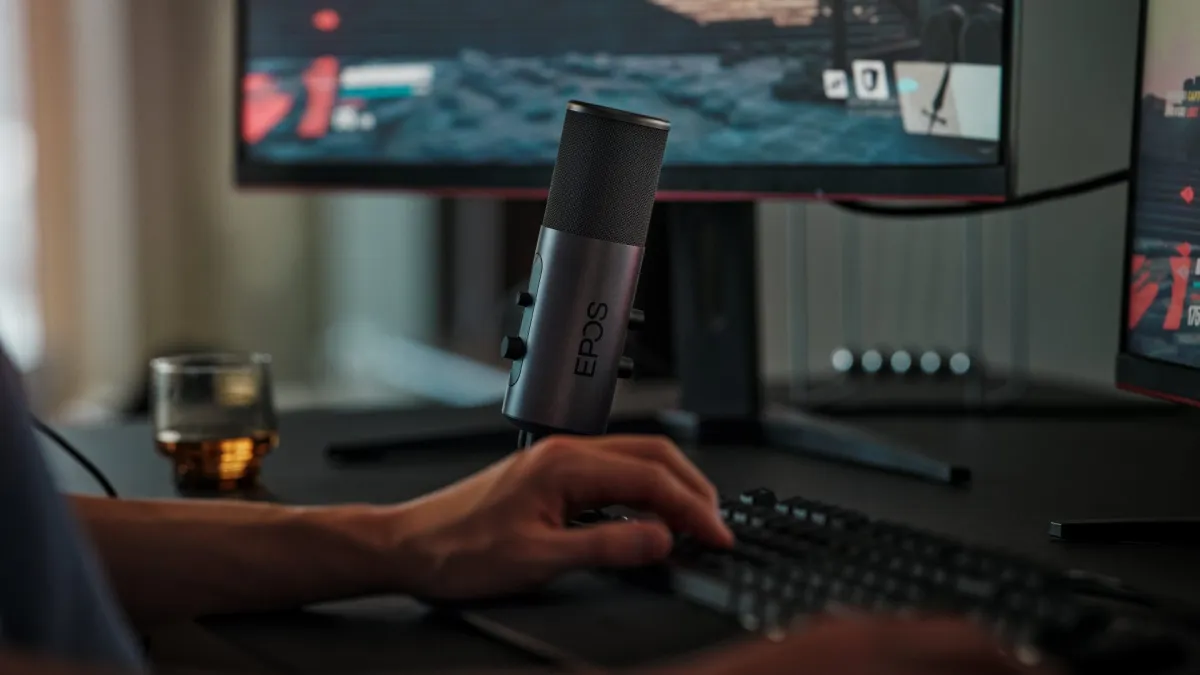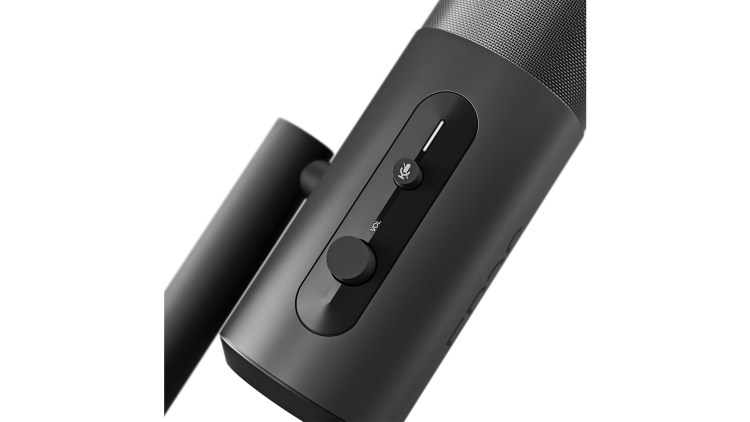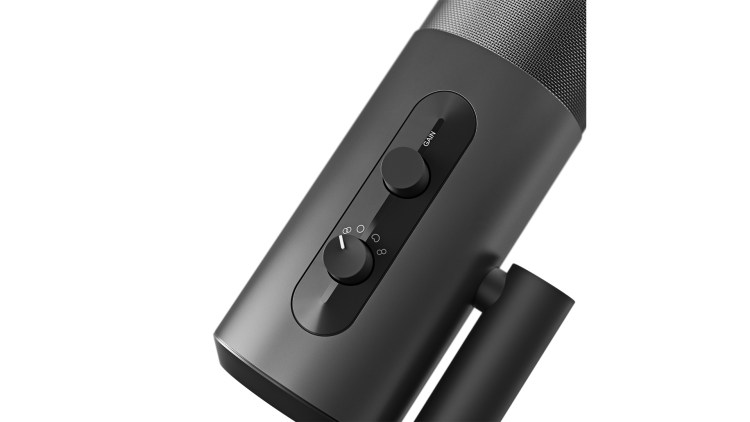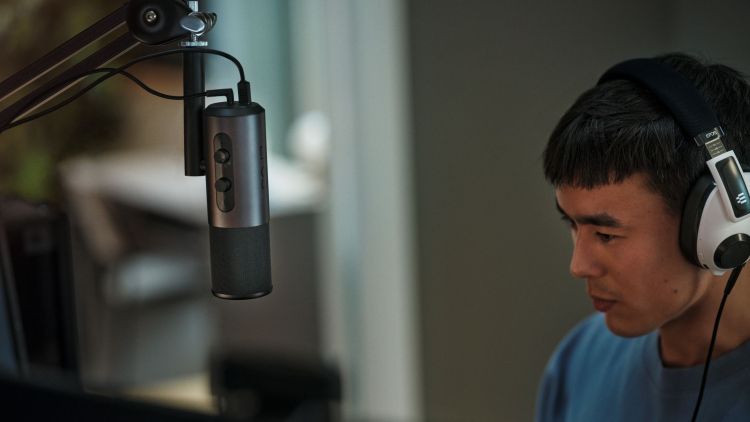With the introduction of the B20 streaming microphone, EPOS now has a desktop mic on offer that’s designed to make audio recordings easier without recording equipment. We tested out the EPOS B20 microphone to see how it performs, and this review will highlight its many strengths along with a few weaknesses to be aware of.
Built primarily for livestreamers and podcasters, this minimalistic USB microphone has almost everything you need right out of the box. Users can simply attach the microphone to the included desktop stand or onto a boom arm with a standard 3/8 inch thread. It also comes with a nine foot USB cable, so cable routing options are versatile. Once the physical setup is done, you just need to download and install the EPOS software, connect a quality pair of headphones for monitoring, and you’re all set to go.
EPOS B20 microphone specs
Measuring about nine inches tall with its stand and only weighing 19 ounces, the B20 certainly gives USB desktop microphones such as the Blue Yeti some major competition. Its black and charcoal gray cylindrical capsule has the EPOS logo engraved down the side opposite the side-mounted adjustable stand, while control knobs protrude from the front and back. On the front is a mute button, a slim LED light that lets you know when the mic is on, and a headset volume knob that’s linked to your Windows volume control. The rear side features an infinitely turning gain control knob along with a switch that changes the polar pickup pattern from the side-facing cardioid pattern to stereo, bidirectional, and omnidirectional. However, the usefulness of having multiple pickup patterns depends on the type of recording you do.
| Feature | Description |
| Controls | Gain, volume knob, mute button & pick-up pattern switch |
| Connectors | USB Type-C, 3.5mm audio jack |
| Compatibility | PC, Mac, PS4, PS5 |
| Frequency response | 50-20,000Hz |
| Pick-up patterns | Cardioid, bidirectional, omnidirectional, stereo |
| Sensitivity | -37 dBV/PA |
| Microphone sensitivity tolerance | +/- 3dB |
| Microphone | Condenser (three capsules) |
| Type | Side-address |
| Thread size | 3/8 in |
| Sample/bitrate | 24-bit, 48 kHz |
| SPL | 112 dB, 2,5% THD |
| Cable | USB Type-C to USB Type-A (9.5 ft / 2 m) |
Combined with its plug-and-play design, the B20 is a straightforward, yet versatile microphone. However, a couple of design issues may make the B20 a little tricky for beginners to work with. If you intend to primarily use it to livestream or record yourself on a podcast, you’ll probably end up sticking with the side-facing cardioid. Group recordings benefit from the stereo, bidirectional (front and back), or omnidirectional modes. The B20 is technically a side-address microphone, but switching it to other modes can turn it into an end-address mic, which brings some nice versatility for those who need it.
What does this button do?
Although connecting the microphone to my computer and installing the software was easy enough, the overall setup process took me a bit longer than I expected. This is largely because the front-facing LED simply lets you know if the microphone is on or muted. There’s no way to know if your volume is peaking or staying in the sweet spot unless you happen to be very good at judging gain levels by listening through headphones. I had to make multiple sound recordings of myself with different settings until I got everything right, almost by accident. What makes the process infuriating is that the LED already switches from white to red when you hit the mute button, so having it do something similar when the gain is set too high would have been a welcome feature.
Configuring the mic for my home office was a complete pain. The B20 is incredibly sensitive, and the infinitely turning gain knob doesn’t give you much of an idea of where it’s set. When I turned the mic on for the first time, it picked up every single background sound, including a fish tank from 10 feet away, my PC fans, and family members watching television in the next room, as if they were all happening right next to the mic. Compounding the issue is how the software-based gain control doesn’t seem to do anything except make the equalizer light up. It doesn’t override the manual control knob the way the volume controls do for headsets, and it still picked up my voice when the gain was supposedly set to 0%. As a result, I ended up wasting a lot of time messing around with the software configuration when what I needed to do was turn down the dial.
Advanced software features include making voice enhancements, setting the side tone, configuring a noise gate, and adjusting the noise cancellation. However, there’s no guide to using these features, so beginners might feel a little overwhelmed with moving sliders around and trying to figure out what everything does. Setting up a noise gate is an interesting feature, but it’s not exactly a great tool. It simply rejects all sounds below a set volume threshold until you start talking, which can sound like you’re suddenly popping in with a flood of environmental noise by turning off the mute. The background noise cancellation works well for the most part, but there are only three settings: off, 50%, and 100%. So, there isn’t much control, and turning it on can degrade the sound quality.
It quickly became clear, as I configured the EPOS B20, that this microphone is perhaps best suited for quiet, preferably sound-treated rooms.
Recording in session
Once everything (including your recording space) is set up, broadcasts sound amazing. With a 50-20,000 Hz frequency response and up to 48 KHz, 24-bits recording quality, my voice came out sounding perfectly natural. You can also use the software-based voice enhancer to modify how your voice is picked up. I ended up using the “warm” equalizer preset.
At the same time, the EPOS software can be used to configure equalizer settings and virtual surround sound for your connected headphones. My only issue with listening to audio through the microphone is that there’s no way to turn off monitoring except by muting the mic altogether, which is a little annoying when you’re happy with the microphone settings and just want to focus on the game sounds.
It’s also worth noting that, similar to many other USB microphones, the stand is almost completely rigid. There’s an arm that is permanently attached to the side of the microphone, which allows you to tilt it when screwed onto its included aluminum base or microphone arm. But keeping it on your desk means that it will easily pick up bumps and other vibrations. In my case, the recordings highlighted how often I would bang my hand on my desk after getting sniped or achieving a rare kill streak. The cardioid setting also didn’t do much to reject the loud clicks from my mechanical keyboard or my mouse, but few standing microphones do. Mounting the B20 onto a microphone arm helped considerably, but vibrations still made it into my recordings since the mic’s unique design means you can’t really put a shock mount on it.
Should you buy the EPOS B20 USB microphone?
Overall, I was impressed with the quality of the EPOS B20 microphone for its $150 USD price point. Although I still think a built-in peaking indicator would be an invaluable tool, the superb recording quality makes up for it. The multiple pick-up patterns feature turned out to be less useful than I thought it would be, but the high degree of versatility is appreciated appreciated. Beginners may experience a bit of a learning curve, given the high sensitivity and software-controlled features such as a high-pass filter, side-tone configuration, and noise gate. The quick-start guide doesn’t help much with these settings, but the software includes a handy recording and playback feature so you can find out how different adjustments impact your sound. Just be prepared for a lot of trial and error.










Published: Jan 27, 2022 10:00 am